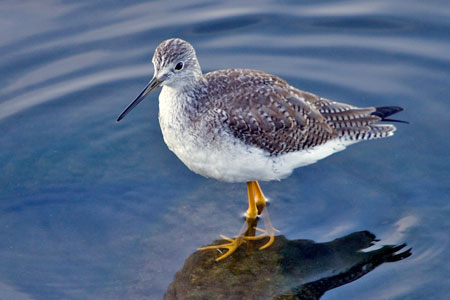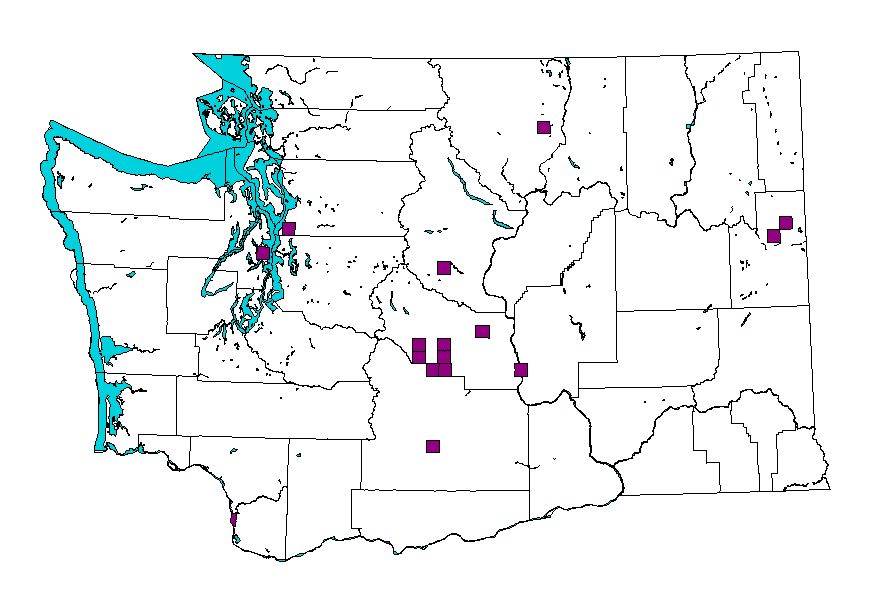
NatureMapping Animal Facts for Kids
Greater Yellowlegs
|
Greater Yellowlegs (Trinca melanoleuca) What they look like: The Greater Yellowlegs is a mottled gray shorebird with long, bright yellow legs - smilar to its smaller relative, the Lesser Yellowlegs. The bill of the Greater Yellowlegs is slender and longer than the diameter of its head, while the bill of the Lesser Yellowlegs is about the length of its head. In breeding plumage, the bill is solid black, whereas in non-breeding plumage it may be lighter gray at the base. The bill may appear slightly upturned (see photo).
Calls:
Calls include a three or four-noted, "dew-dew-dew."  Photo courtesy of Natures Pics.
Photo courtesy of Natures Pics.Where they live: Greater Yellowlegs breed in muskeg bogs in the northern boreal forest. Their wintering and migration habitats are more general; they can be found in many fresh and saltwater wetland habitats, including open marshes, mudflats, estuaries, open beaches, lakeshores, and riverbanks. In comparison to Lesser Yellowlegs, Greaters are typically found in more open areas, on larger bodies of water, and on more extensive mudflats. The Greater Yellowlegs winters along the coast of Washington, south to Baja California and Mexico, on coastal mud flats and marshes. It breeds on tundra from Cooke Inlet in Alaska and south all across Canada. Uncommon to rare winter resident in Washington, both fresh and salt water. (BirdWeb) Click the range map to learn more about the distribution of Greater Yellowlegs in Washington.
What they eat: Greater Yellowlegs mainly eat insects and insect larvae during the breeding season. During winter and migration, small fish, crustaceans, snails, and other aquatic animals round out the diet. Behavior: Greater Yellowlegs are less social than many shorebirds, and small flocks form during migration. Outside of the breeding season, most foraging takes place in shallow water. They often feed actively, running after fish or other fast-moving aquatic prey. Greater Yellowlegs swing their heads back and forth with the tips of their bills in the water, stirring up prey, but are less likely to use this foraging technique than are Lesser Yellowlegs. The Greater Yellowlegs bobs the front half of its body up and down, a characteristic behavior of this genus. Greater Yellowlegs are wary, often the first species to sound an alarm when a perceived threat approaches. Greater Yellowlegs are known for their piercing alarm calls that alert all the birds in the area. Their flight call consists of a series of 3 or 4 notes.  Photo courtesy of Natures Pics.
Photo courtesy of Natures Pics.Nesting: Due to its low densities and remote nesting areas, the breeding biology of the Greater Yellowlegs is not well studied, and much is unknown about it. They are presumed to be monogamous, and pairs form shortly after they arrive on the breeding grounds. Like the Lesser Yellowlegs, the nest is on the ground, close to the water. It is well concealed in a shallow depression, under a low shrub or next to a moss hummock. The nest is sparsely lined with grass, leaves, lichen, and twigs. Both parents probably help incubate the 4 eggs for 23 days. The young leave the nest soon after hatching and find their own food. The parents appear to tend the young at least until they are capable of fluttering flight, at 25 days, and may stay until they are strong flyers, at 35-40 days. Pairs raise a single brood during the breeding season. They have a tendency to breed in inhospitable, mosquito-ridden muskegs which makes it one of the least-studied shorebirds on the continent. (source: BirdWeb)
Did you know?

Greater Yellowlegs More information:
|
